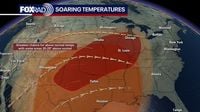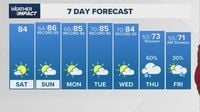The early morning in Houston, Texas, on November 16, 2025, brought with it a soft, milk-gray haze, curling over medians and open fields, and dimming the streetlights along Beltway 8. Commuters found themselves navigating wet, glistening pavement as patchy fog lingered across the city. According to the National Weather Service, visibility dipped near sunrise, especially along major corridors like I-45 and the Southwest Freeway, prompting meteorologists to urge drivers to slow down and exercise caution.
But as the sun climbed higher, the fog dissipated, unveiling a stretch of unseasonably warm, almost springlike air. By mid-morning, temperatures pushed into the lower 80s, and the humidity, stubbornly elevated, gave the air a thick, moist feel. For Houstonians planning errands or early holiday preparations, the fast warm-up was a reminder that this November would be anything but typical. As one local meteorologist put it, "Pool weather is not out of the question."
The pattern of warmth was no isolated event. The high-pressure ridge parked over Texas was pulling in humid air from the Gulf, setting the stage for near-record high temperatures throughout the weekend and into the start of Thanksgiving travel week. According to FOX 26, forecast highs hovered in the mid-80s from Sunday through Tuesday, putting daily records in jeopardy. In fact, Sunday, November 16, and Tuesday, November 18, were both flagged as days when Houston could break existing temperature records—a trend echoed across nearly 100 cities nationwide, many of which had recently tied or surpassed their own record highs.
Saturday, November 15, had already delivered above-average warmth, with temperatures in the 80s. After sunset, the mercury dipped into the 70s and 60s, but the respite was brief. Fog redeveloped overnight, only to clear again as the sun rose on Sunday. The National Weather Service forecasted south winds at 5 to 10 mph through Sunday evening, with a chance that fog would return in the early hours of Monday. The result: a string of days that felt more like late summer than the heart of autumn.
Underlying this persistent warmth were several atmospheric factors. As the Houston Chronicle explained, a stubborn ridge of high pressure—sometimes referred to as an "omega block"—had dominated the mid- and upper-levels of the atmosphere since the start of meteorological fall on September 1. This pattern, akin to a fall version of the infamous summer "heat dome," kept much of central and western U.S., including Houston, warmer than normal. Sea surface temperatures in the Gulf of Mexico were also running about three degrees above average, further fueling the city’s balmy conditions.
Houston’s official climate site at Bush Intercontinental Airport recorded an average high of 88.3°F between September 1 and November 10, the second warmest for that period on record. While there was a brief taste of fall when temperatures dropped to 37°F on November 12, most cold fronts this season had originated over the northern Pacific and brought only fleeting relief. As a result, this fall ranked as Houston’s ninth warmest based on average temperature through November 10, a rarity in weather records dating back to 1889.
For many residents, the persistent warmth had tangible effects beyond the thermometer. Allergy sufferers, especially those sensitive to ragweed pollen, found the season particularly challenging. According to local meteorologists, the lingering heat allowed ragweed pollen to persist deep into fall, and without a hard freeze, relief remained elusive. "If you suffer from ragweed pollen, this fall has likely been difficult," the Houston Chronicle noted, adding that pollen levels would only truly subside once Houston experienced freezing temperatures.
The warm, humid pattern was not without its downsides. Widespread severe and moderate drought conditions continued to grip the region, affecting Fort Bend, Harris, Liberty, Chambers, and Galveston counties, among others. According to FOX 26, nearly the entire Houston viewing area was under some level of drought risk. However, there was hope on the horizon: forecast models suggested that about one to two inches of rain could fall across much of the area within the next seven days.
Rain chances were set to rise as two separate weather systems approached. The first, expected to pass to the north on Wednesday, November 19, might bring a few light showers. The second, a stronger low-pressure system with an attached front, was forecast to arrive late Thursday into Friday, November 20-21. This front was expected to bring not only rain but also the potential for strong to severe thunderstorms—a risk heightened by the unseasonably warm temperatures and elevated humidity. As Click2Houston reported, "The front may also produce strong to severe thunderstorms, which will require monitoring."
By the end of the week, the much-anticipated cold front was projected to sweep through, finally breaking the warm spell. Highs would drop into the 70s, and lows would settle into the 50s, bringing temperatures closer to seasonal norms for late November. The rain accompanying the front could spell travel delays, particularly for those heading toward Bush Airport or making other Thanksgiving journeys. While the timing was still subject to adjustment, meteorologists were optimistic that the front would also help alleviate drought conditions and provide some much-needed relief from persistent allergies.
Looking ahead, the extended forecast hinted at cooler, more typical autumn weather in the days following the front. However, the broader climate outlook suggested that Houston’s experience of fall—and possibly winter—would continue to be shaped by larger patterns. With La Niña conditions developing in the eastern equatorial Pacific, experts anticipated a warmer and drier winter for Houston and much of Texas, although brief cold snaps or even a rare snow event couldn't be ruled out entirely.
As Houston residents enjoyed one last stretch of pool weather and prepared for the possibility of storms later in the week, the city’s meteorologists kept a close eye on the evolving forecast. The story of Houston’s 2025 fall weather was one of extremes: record-breaking warmth, stubborn drought, persistent allergens, and the ever-present hope for rain and a return to sweater weather. For now, the city remains in the grip of a historic autumn, its residents watching the skies for the first real sign of seasonal change.


